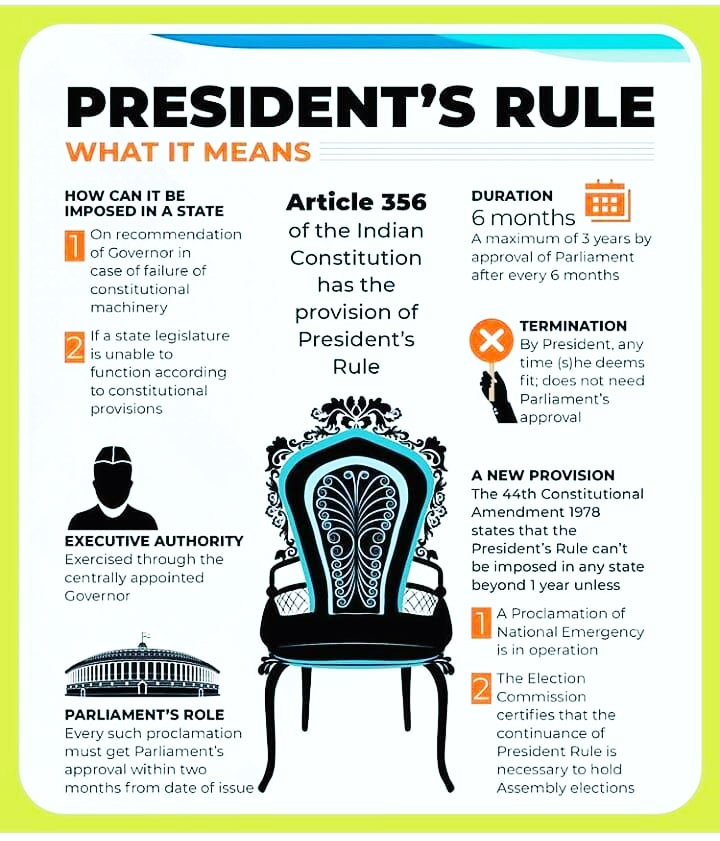Article 356 | 26 Dec 2020
This article is based on “Article 356 and an activist judiciary” which was published in The Hindu on 26/12/2020. It talks about the Article 356 and recent Andhra Pradesh High court’s order to sou-moto question of a “constitutional breakdown” or the failure of constitutional machinery in Andhra Pradesh.
Recently, the Supreme Court stayed the Andhra Pradesh High Court order that sought to convene a suo moto judicial inquiry into whether there is a “constitutional breakdown” in the Andhra Pradesh Government.
This was clearly a case of judicial overreach by the A.P. High Court. The question of a “constitutional breakdown” or the failure of constitutional machinery is dealt with under Article 356 of the Constitution, whose invoking comes under the prerogative of the executive and not the judiciary.
Though the Supreme Court has rightfully intervened in a tussle between the judiciary and the elected government in Andhra Pradesh, the A.P High court’s order opens up the possibility of use or even misuse of Article 356 by the judiciary.
Hence, there is a need for making essential changes to the constitution, so as to stop the misuse of Article 356 and strengthen Indian Federalism in true spirit.
Article 356: Background
- No liberal democratic Constitution in the world has a provision such as an Article 356 that gives the central government the power to dismiss a democratically-elected State government except the Constitution of Pakistan.
- Both India and Pakistan borrowed this provision from the Government of India Act, 1935.
- The leaders of the Indian freedom struggle were so very opposed to this provision that they forced the British government to suspend it. Section 93 of the Government of India Act, 1935 was never brought into effect.
- However, the provision which we had opposed during our freedom struggle was incorporated in the Constitution for the preservation of democracy, federalism and stability in the post-independent era.
Article 356 And Its Misuse
- Even though B.R. Ambedkar had assured that it would remain a dead letter, Article 356 has been used/misused more than 125 times.
- In almost all cases it was used for political considerations rather than any genuine breakdown of constitutional machinery in the States.
- Former Prime Minister Indira Gandhi used Article 356 as many as 27 times, and in most cases to remove majority governments on the ground of political stability, absence of clear mandate or withdrawal of support, etc.
- In retaliation, the Janata government removed nine state Congress governments, when for the first time they formed the government in 1977.
- Indira Gandhi on her return to power in 1980, removed nine Opposition majority governments at one go.
- Subsequent governments too acted in a similar fashion.
Article 356 And Safeguards
- The 1994 Supreme Court (S.R. Bommai case) majority decision, in essence, overturned a long tradition that the use of Article 356 was not really subject to review by courts, a doctrine articulated in a landmark 1977 case, State of Rajasthan vs Union of India.
- The Bommai case verdict laid down the conditions under which State governments may be dismissed, and mechanisms for that process.
- In the S.R. Bommai case, a nine-member bench of the Supreme Court construed the scope of Article 356, which also allows the imposition of President’s Rule in the States, with stringent conditions.
- These included ascertaining whether objective conditions exist which render it impossible to carry out governance in the State where the proclamation has been made and the process has to be approved by both Houses of Parliament before consideration for judicial review.
Way Forward
- Judiciary Restraining Itself: Judiciary should realise that Judicial activism may be good as a rare exception but an activist judiciary is neither good for the country nor for the judiciary itself.
- Fine-tuning Role of Governor: In order for the smooth functioning of democratic government and strengthening the spirit of federalism, it is important that the governor must act judiciously, impartially and efficiently while exercising his discretion and personal judgment.
- In this context, the recommendations of the Sarkaria Commission and Punchhi Commission should be followed in true spirit.
- For example, the 'procedure for appointment of governors should be clearly laid down' and conditions of appointment must also be laid down and must assure a fixed tenure for the governor.
- Need for President’s Activism: President under the Indian constitution is bound by the aid and advice of the Indian Constitution. However, the President can use its suspensive veto in case of malicious application of Article 356.
- For example, former president K.R. Narayanan twice returned the cabinet’s recommendation on October 22, 1997, in respect of the Kalyan Singh government in Uttar Pradesh which had just won the controversial confidence vote and stating that imposition of President’s Rule would be constitutional impropriety.
Conclusion
The nullification of the A. P High Court order by the Supreme Court will ensure that such legal adventures impinging upon the separation of powers in the State are curtailed. However, in order to prevent repeated misuse of Article 356 major constitutional amendments and strong political will is required.
|
Drishti Mains Question There is a need for making changes to the constitution, so as to stop the misuse of Article 356. Discuss. |
This editorial is based on “Vocal for local: On J&K DDC polls” which was published in The Hindu on December 24th, 2020. Now watch this on our Youtube channel.

